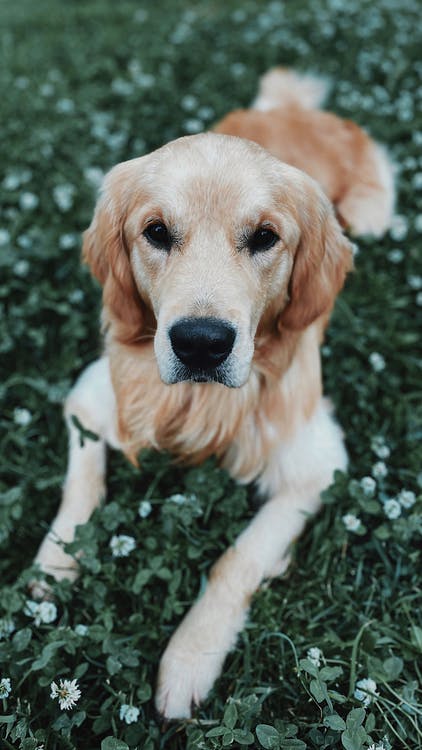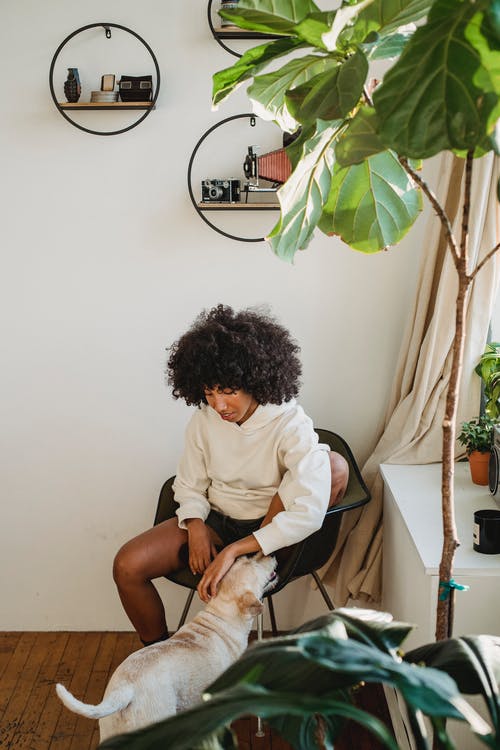A dog that spins, jumps up and down, and barks is not a happy dog. These are all signs of euphoria. The dog has extra energy. The only way his brain knows how to deal with him is to let his body consume him.
Unfortunately, people often interpret these signals as happiness. Many people also tend to think that dogs are cute and eventually encourage this behavior unconsciously. By controlling your dog’s excitement, you can prevent future misconduct, including attacks.
Can you tell whether they are anxious or happy? Do you need help to calm them down? Well, you’ve come to the right place to learn how to calm down your dog.
Why Puppies Become Overly Excited?
Some dogs are naturally more active, such as the golden retriever, Labrador Retriever, border collie, Australian Shepherd, Doberman Pinschers, and Rottweiler. Other dogs may also be naturally more active. Many dogs begin to settle down between six months and a year.
Generally speaking, most dogs will obviously calm down between 18 and 24 months. Of course, smaller varieties usually mature faster than larger varieties.
Many dogs are overstimulated by environmental factors. This can happen when a puppy sees or hears something.
For example, seeing another dog or squirrel while walking. Or when you or a visitor comes in.
Such an event will make the dog over-excited. Even play can ignite a dog’s energy and make him drive faster.
An overstimulated puppy may bark, purr, growl, jump, spin, mouth you or clothes, and it is not easy to settle down.
Of course, dogs usually show some excitement when a stimulus event occurs. They should not be robots.
However, when the dog exceeds the threshold, its behavior will become a problem and can not be stabilized quickly.
Why Teach a Puppy To Calm Down?
We might think it’s cute for an eight-week-old dog to jump on us and even pull our socks.
But wait till he turns into an 80-pound Labrador Retriever and pours on you when you get home. This is a completely different picture.
I believe this is not the behavior you want.
A puppy who does not know how to be calm in childhood can easily become an out-of-control adult.
Hyperactive excitement can be addictive to dogs. But hyperactive dogs don’t really have fun.
Adolescent and adult dogs are often resettled for lack of impulse control. So it is important to teach your puppy how to calm down.
When Do Puppies Calm Down
“Can my dog really calm down?” Yes, we have heard this question before. The answer is, well, it depends.
Your puppy will grow up emotionally with age and given appropriate training and social experience, he will not feel so stressed and depressed about the world. So, yes, the puppy’s energy will certainly fade, but if you don’t teach your puppy these important life skills and how to become a good dog in society, for example, when you see another dog, you won’t lose your mind, then this situation is likely to continue, so it’s best to start now.
You can learn everything you need to know about teaching your puppy obedience exercises in our guide.
Some breeds are indeed more “busy” than others. Grazing breeds and terriers have been developed to engage in specific jobs, requiring them to stand up quickly and react quickly. These breeds need an export of energy, and happily, our zigzag puppy training app has a dedicated program for each breed.
Methods To Calm Your Puppy Down

It’s easy to keep the dog quiet; All that is needed is a little patience and organized thinking. Below we list the best tips for keeping your puppy quiet. We promise that the Zen day will come soon!
Psychomotor
In order to calm the dog down, mental stimulation is as important as physical exercise. This exhausts him in a positive way.
Of course, obedience training is also very important. The same is true of educational toys and other educational toys and games.
They help expand your puppy’s mind and consume energy. Even a low, fun puppy agility course can help with physical and mental exercise.
Physical Exercise
As with all canine behavior studies, moderate exercise is critical to success.
Puppies generally do not need much exercise. However, according to your dog’s age and breed, as long as he is healthy, he should exercise.
A walk will help. Even a game of grabbing or pulling.
You can even play hide and seek to help your dog get tired. It also helps him remember.
When your dog is lying on the floor, you can let someone gently grasp its collar. Then hide in the corner of the next room or behind the chair.
Suppose it knows its own name and calls its name in a happy voice. Praise and reward him when he comes to you.
Obedience Training
Of course, obedience training can help us communicate with dogs and tell them our rules in a positive way.
Teaching behaviors involving impulse control can really affect your puppy’s behavior. These include: sit down, sit down, stay, wait, see, give, put down, be quiet, and then leave.
When your puppy learns these without interference, add low levels of interference, then high levels of interference, until he can reliably complete them anywhere.
The purpose of doing this is to make him make the default behavior of sitting down or sitting down under the previous overstimulation.
At the same time, before he eats, crosses the road, or goes out for a walk, do some impulse control exercises and ask him to sit down.
In addition to formal obedience, teaching techniques can also be a tool in your arsenal to engage your puppy in calm behavior.
Reward Calm Behavior
This is similar to teaching a dog to solve a problem without giving a verbal prompt. In dog training, the reward behavior will be repeated.
So, when we teach dogs that we want to behave calmly, calmly praise and reward your dog.
In the beginning, you can even reward it while it sits still. Eventually, you will raise standards, praise, and reward other calm behaviors, such as lying down.
Then further increase the expectation before rewarding his behavior, such as praise and reward, only after he lies quietly for longer and longer.
You can increase the expected time in seconds for success. Don’t expect too much in a short time. If you do this all the time, your dog will do it himself.
When you catch your dog more relaxed, create a more relaxed posture.
Observe whether his facial expression and body language are tense or calm and whether his breathing is hard or relaxed. Create and reward more relaxed postures.
Taking Breaks
It is important that your puppy does not exceed the threshold when playing or engaging in any activity.
If you are playing ball picking or pulling, be sure to rest frequently, so that your dog will not be too excited and can not settle down.
Then play for a short time. Be sure to finish before your dog gets overstimulated.
Even if you’re training your puppy, finish the training before he loses control. For example, you should be excited to ask him to come, but don’t be so excited that he starts to jump around on you.
Short downtime really helps. Usually, rest may only take a few minutes, depending on the dog. Some more motivated puppies take longer to calm down.
Teach a Command of “Stability”
Teaching a puppy to settle down as prompted is like having an “off” switch before he overstimulates.
When teaching this, I must first make sure that the dog has enough exercise before training.
For example, after walking the dog belt, I would sit on a chair with the dog, who was still wearing the dog belt. A six-foot belt is usually the best choice.
After playing indoors, I would put a belt on him and do the same training.
If he keeps doing this, he should know that calm behavior will be rewarded.
Once he knows what you want, you will praise and reward him after he settles down for a period of time. You may reward him for a few seconds at first, and then expect him to calm down for a while before reinforcing his behavior.
Manage Your Puppy’s Environment
If your puppy barks out of the window when he sees someone passing by, close the blinds or otherwise make him invisible. If it is impossible, he can even stay in another room until he learns to ignore the stimulus.
The same thing applies to the external noise he barks at or other excessive excitement. Close the window and play a low-volume TV or white noise to block the stimulating noise.
If your dog barks and jumps in your fenced yard, don’t let him continue to practice these annoying behaviors outside alone. Instead, you should shift his energy to desired activities, such as playing games or obeying orders.
Generally speaking, it is best not to leave the puppy unattended. They can swallow dangerous goods and even escape from the yard. Unfortunately, they can even be stolen.
If your puppy becomes overly excited when someone enters the door, deal with the problem until it learns a behavior, such as sitting by default.
When he was studying, put a belt on the front door and put it on him so that he would not jump. Don’t drag him down. Instead, stand far enough from the door so that he can’t reach the guests.
Praise and reward him when he is calm. Of course, when working with him, you should do some exercises so that when the real situation happens, he can calm down.
If your dog is too excited about something while walking, such as noise, vehicles, people, or other animals, work with him at a distance he can handle. Then, reward calm behavior.
When he excels at 20 feet, he goes to 19 feet to practice. It’s important to follow his rhythm. If he has any setbacks, just start practicing again on the distance of his success.
At the same time, manage his indoor environment. Put his shoes and other things out of his reach.
Limit him to a place where you can observe him. Use the door, baby door, exercise pen, and crate properly.
You can also manage his environment by tying him to you so that he doesn’t do unwanted behavior. At the same time, you can reward the behavior you want.
But I want to remind you not to overuse the dogs tied to you, because if they are always with you and then suddenly left alone, it may cause separation anxiety in some dogs.
Teach a “Settle” Command
Once the puppy understands what expectations are, you can even play with him after he settles down for a while. Then, let him settle down.
This can be done. My Australian rescue dog Millie is an energetic dog. In addition to playing ball (her favorite game), I trained her to obey orders and skills.
But when he was a puppy, it was very important to teach his “stability” in our daily life. If I don’t deal with it, it doesn’t have a natural “off” switch, and it will start to do some unnecessary behaviors, such as excessive barking and jumping.
Another similar impulse control exercise is to teach your puppy to go to a place, such as a dog bed.
You can give the prompt “bed” and put some snacks on the bed. Praise him when he is in bed.
You can also do this by enticing your puppy to bed and then praising and rewarding him when all four legs are in bed.
Over time, reward him after he lies in bed for a few seconds. Gradually increase the criteria for rewarding him.
After he knows to sit down, sit down and stay, you can also practice these on the mat.
Finally, you can take him to bed and let him lie down and stay there. Of course, this requires a lot of patience and practice.
Using Sedation Techniques
It is very important to keep calm when teaching your puppy to keep calm. Do not raise your voice or show excitement or excitement.
I know it’s easier said than done. But if you get excited, your puppy will probably eat it and become more excited. An insecure dog may even be afraid of you.
So, in addition to using the other techniques discussed in this article, stay calm. Turn your back or leave your jumping or barking puppy.
Don’t yell at him or push him away. This may lead to some potential reactions and attacks.
There are other ways to help the dog calm down. Soothing music can help some dogs. There is even music specially designed for it called through a dog’s ear.
The correct use of Lei Shan can help the dog calm down. There are other general AIDS, such as sedative pills.
Expect Some Natural Stimulation
Of course, our puppy should be excited about the new excitement. I want my dog to enjoy their life and environment. I’m sure you know, otherwise, you wouldn’t have read this article.
But when they are too excited to calm down, we want to avoid it.
This also applies to the zoom of the puppy. They are normal. Many puppies suddenly start running frantically in some cases, then suddenly fall down and doze off.
If they happen frequently, it is not normal. However, a few times a day is usually nothing to worry about.
Veterinary Help
If you have been trying to calm your puppy down with effective methods, but you have not seen progress, a veterinary examination may be appropriate.
There may be a medical reason why your puppy can’t calm down.
Behavioral Help
If you don’t see continuous and correct improvement using the above techniques, you should consult a strengthening trainer or behaviorist who has successful experience in calming the puppy.
What Never to Do?
In order for your puppy to do this, it is important to keep calm. Don’t shout or show excitement.
Also, don’t try to suppress your puppy’s behavior. Many years ago, when trying to correct a behavior, some people used some rough methods, such as pressing the dog on the ground or turning it over. Some coaches still use them.
These methods have been abused. And not only will they not work for a long time, but they will also lead to more unnecessary behaviors, such as attacks.
Modern training methods are benevolent and science-based. And if they are operated correctly, they will work!
Summary
The dog is so cute. But they may also seem out of control and excited.
They are barking, pulling our clothes and hands, whining, and running around at will. But you can teach them to calm down.
It helps to make sure they have enough mental and physical stimulation. Keeping calm, rewarding your dog for calm behavior, and managing his environment can help your dog settle down.
We hope you enjoy this article that teaches your dog to calm down.





